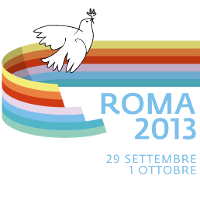My warmest Greetings to: Your Excellencies, Ladies and Gentlemen.
Before I begin my talk, I would first like to thank the Community of Sant’Egidio for inviting me to talk at this ‘International Meeting for Peace’.
My topic for this meeting is “Let Ourselves be Questioned by Suffering”.
Please allow me to start with the definition of ‘suffering’. In an ordinary sense, suffering may be defined as ‘the bearing of or distress’; in Buddhism, ‘suffering’ may be interpreted as ‘Dukkha’; the Buddhist believe that all things are suffering. Dukkha is one of the three basic characteristics of existence; the other two being ‘Anicca’ and ‘Anatta’. All our lives are governed by these three characteristics, ‘Anicca’, ‘Dukkha’, ‘Anatta’.
The modern world in which we live in today, has become far advanced in Information Technology, compared to the world fifty years ago; the IT has made it possible to make good progress in communications, medicines, science, education, economics and in all other areas we can think of. Today, the IT and our personal computers have made it so easy for us to find the required information instantly. We no longer require writing down pages after pages and storing them in bulky files. What the IT have done is to make our living easier and help us to reduce our worries. This is a good thing.
However, we all know that if there is a ‘good thing’, there will also be an opposite, ‘bad thing’, just as, happiness is opposite to suffering.
We are all aware of the First World War, the Second World War and so many small wars in between which are still going on today. We can imagine how many people were killed and how they suffered.
The IT has made the world modern and it has also brought with it the destructive nuclear powers; short range and long range missiles, and the nuclear bombs that can destroy the whole world at a fingertip. The possibility of a Third World War is not a far fetched one. This imaginary worry can become a reality, and this is a real worry; this is a real suffering.
We all live to enjoy life; we all want things. The majority live with a hope that one day they will have everything. The majority die just hoping. To put it simply, life for all of us will be never satisfied, and the suffering will always be there in all of us.
When our Lord Buddha became enlightened, his very first sermon to ‘Pan-sa Wag-gi’ = the five wisest disciples, emphasized the causes of six categories of sufferings as follows:
1 Lying in pregnancy inside a mother’s womb is suffering;
2 Growing old is suffering;
3 Falling ill is suffering;
4 Dying is suffering;
5 Living together with a person whom one does not love, and living apart from a person whom one loves; and
6 Not getting what one wants in life.
The Lord Buddha said these are truly the ‘Dukkhas’, the sufferings.
According to what the Buddha taught, we are suffering daily, in one way or the other. We are afraid to grow old; we are angry at not finding a preventive medicine for our old age. We do not want to suffer pain, and we are suffering because we cannot find a cure. We are most afraid when we are about to die. Everyday, we all suffer and we all die. The Lord Buddha said this ‘suffering’ is “Dukkha Tissa”, one of the Four Noble Truths. No one can escape from this suffering.
In respect of suffering by different people, if I may turn to a few light hearted questionnaires!
Q One person was asked what was the worst suffering that he has experienced in life.
A worst suffering was at a time when he urgently wanted to do toilets, and he could not find one.
Q A child was asked what was the worst suffering that she
has experienced in life?
A The child said it was at a time when the family was passing a ‘McDonald’, and the parents refused to buy her a ham-burger.
Q A young girl was asked what was the worst suffering that
she experienced in life?
A She answered that it was at a time when her parents forced her to marry a man whom she does not love.
Q The same question was put to a mental patient.
A This person replied that his worst suffering was at a time when doctors gave him a medicine to quiet him down.
It was an attempt to find out the meaning of suffering and we have received different answers from different people.
As I have indicated above, the Lord Buddha has preached us that living and dying, and being reborn again and again, is the worst kind of suffering. He taught us ways how to escape from this circle of rebirth. Until and unless we can escape from this circle of rebirth, we will have to go through again and again the process of suffering, namely, [Zarti] lying in pregnancy and being born, [Zarar] growing old,[Byardi] falling ill and [Marana] dying. The Lord Buddha did showed us a way to break through this circle of rebirth by practicing ‘Wipathana or Insight Meditation’, which involve sharpening one’s concentration and building up his or her inner wisdom, to attain the final goal of Nibanna.
May I wish you all peace, happiness and tranquility.
|

